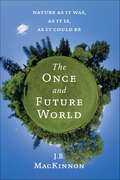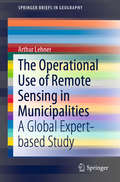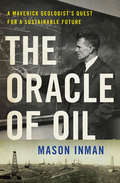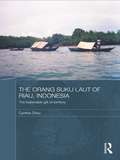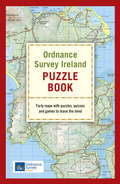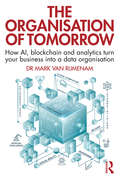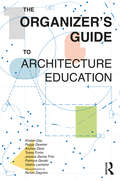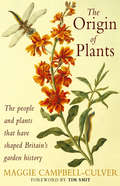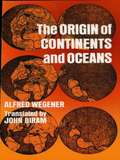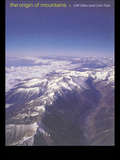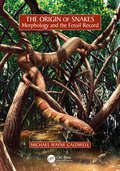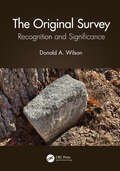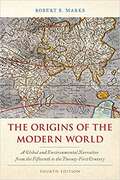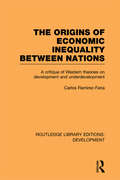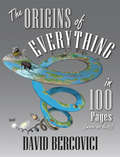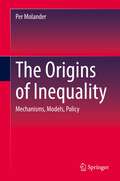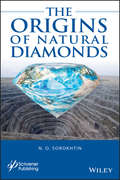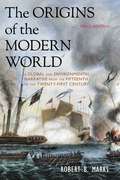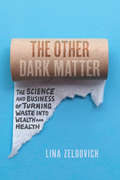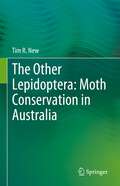- Table View
- List View
The Once and Future World
by J. B. MacKinnonFrom one of Canada's most exciting writers and ecological thinkers, a book that will change the way we see nature and show that in restoring the living world, we are also restoring ourselves. The Once and Future World began in the moment J.B. MacKinnon realized the grassland he grew up on was not the pristine wilderness he had always believed it to be. Instead, his home prairie was the outcome of a long history of transformation, from the disappearance of the grizzly bear to the introduction of cattle. What remains today is an illusion of the wild--an illusion that has in many ways created our world. In 3 beautifully drawn parts, MacKinnon revisits a globe exuberant with life, where lions roam North America and 20 times more whales swim in the sea. He traces how humans destroyed that reality, out of rapaciousness, yes, but also through a great forgetting. Finally, he calls for an "age of restoration," not only to revisit that richer and more awe-filled world, but to reconnect with our truest human nature. MacKinnon never fails to remind us that nature is a menagerie of marvels. Here are fish that pass down the wisdom of elders, landscapes still shaped by "ecological ghosts," a tortoise that is slowly remaking prehistory. "It remains a beautiful world," MacKinnon writes, "and it is its beauty, not its emptiness, that should inspire us to seek more nature in our lives."
The Once and Future World: Nature as It Was, as It Is, as It Could Be
by J.B. MacKinnonAn award-winning ecology writer goes looking for the wilderness we&’ve forgottenMany people believe that only an ecological catastrophe will change humanity&’s troubled relationship with the natural world. In fact, as J.B. MacKinnon argues in this unorthodox look at the disappearing wilderness, we are living in the midst of a disaster thousands of years in the making—and we hardly notice it. We have forgotten what nature can be and adapted to a diminished world of our own making.In The Once and Future World, MacKinnon invites us to remember nature as it was, to reconnect to nature in a meaningful way, and to remake a wilder world everywhere. He goes looking for landscapes untouched by human hands. He revisits a globe exuberant with life, where lions roam North America and ten times more whales swim in the sea. He shows us that the vestiges of lost nature surround us every day: buy an avocado at the grocery store and you have a seed designed to pass through the digestive tracts of huge animals that have been driven extinct.The Once and Future World is a call for an &“age of rewilding,&” from planting milkweed for butterflies in our own backyards to restoring animal migration routes that span entire continents. We choose the natural world that we live in—a choice that also decides the kind of people we are.
The One-Straw Revolution: An Introduction to Natural Farming (New York Review Books Classics)
by Wendell Berry Frances Moore Lappe Larry Korn Masanobu FukuokaCall it "Zen and the Art of Farming" or a "Little Green Book," Masanobu Fukuoka's manifesto about farming, eating, and the limits of human knowledge presents a radical challenge to the global systems we rely on for our food. At the same time, it is a spiritual memoir of a man whose innovative system of cultivating the earth reflects a deep faith in the wholeness and balance of the natural world. As Wendell Berry writes in his preface, the book "is valuable to us because it is at once practical and philosophical. It is an inspiring, necessary book about agriculture because it is not just about agriculture." Trained as a scientist, Fukuoka rejected both modern agribusiness and centuries of agricultural practice, deciding instead that the best forms of cultivation mirror nature's own laws. Over the next three decades he perfected his so-called "do-nothing" technique: commonsense, sustainable practices that all but eliminate the use of pesticides, fertilizer, tillage, and perhaps most significantly, wasteful effort.Whether you're a guerrilla gardener or a kitchen gardener, dedicated to slow food or simply looking to live a healthier life, you will find something here--you may even be moved to start a revolution of your own.
The Operational Use of Remote Sensing in Municipalities: A Global Expert-based Study (SpringerBriefs in Geography)
by Arthur LehnerThis book presents the operational use of remote sensing in municipalities for urban planning purposes. Through a unique study among more than 70 cities and institutions in 41 countries, it reveals the remaining gap of knowledge and awareness for remote sensing data, methods, and instruments. It sheds light on the uncertainties and shows what remote sensing data are acquired and by which departments they are used. The tasks and activities remote sensing data are used for, are extensively presented. In the times of open government data, digital citizenship and participation movements, this book provides a comprehensive overview of the topic and intends to raise the awareness for the importance of remote sensing to the society.
The Oracle of Oil: A Maverick Geologist's Quest for a Sustainable Future
by Mason InmanThe first comprehensive biography of Marion King Hubbert, the "father of peak oil." In 1956, geologist and Shell Oil researcher Marion King Hubbert delivered a speech that has shaped world energy debates ever since. Addressing the American Petroleum Institute, Hubbert dropped a bombshell on his audience: U.S. oil production would peak by 1970 and decline steadily thereafter. World production would follow the same fate, reaching its peak soon after the turn of the millennium. In battles stretching over decades, Hubbert defended his forecasts against opponents from both the oil industry and government. Hubbert was proved largely correct during the energy crises of the 1970s and hailed as a "prophet" and an "oracle." Even amid our twenty-first-century fracking boom, Hubbert's underlying logic holds true--while remaining a source of debate and controversy. A rich biography of the man behind peak oil, The Oracle of Oil follows Hubbert from his early days as a University of Chicago undergraduate to his first, ill-fated forays into politics in the midcentury Technocracy movement, and charts his rise as a top geologist in the oil industry and energy expert within the U.S. government. In a deeply researched narrative that mines Hubbert's papers and correspondence for the first time, award-winning journalist Mason Inman rescues the story of a man who shocked the scientific community with his eccentric brilliance. The Oracle of Oil also skillfully situates Hubbert in his era: a time of great intellectual ferment and discovery, tinged by dark undercurrents of intellectual witch hunts. Hubbert emerges as an unapologetic iconoclast who championed sustainability through his lifelong quest to wean the United States--and the wider world--off fossil fuels, as well as by questioning the pursuit of never-ending growth. In its portrait of a man whose prescient ideas still resonate today, The Oracle of Oil looks to the past to find a guiding philosophy for our future.
The Orang Suku Laut of Riau, Indonesia: The inalienable gift of territory (The Modern Anthropology of Southeast Asia)
by Cynthia ChouLand reform has been an indisputable part of Indonesian revolution. The consequent execution of development programmes for nation-building have provoked intense hostility over territorial rights. Global market forces in Indonesia have seen increasing flows of transnational investments, technology and resources that have resulted in great demand on sea and land spaces. In this momentum of change, several aspects of rural culture including indigenous populations, like the Orang Suku Laut (people of the sea) of Riau have been deemed by the state architects of development programmes to hinder progress. For generations, the sea and coastal places have been the life and living spaces of the Orang Suku Laut and they claim ownership to these territories based upon customary laws. The developmental pressure thus generated has led to intense struggles over territorial rights. It has also raised issues concerning the social assimilation of indigenous peoples as citizens, religious conversion and cultural identity. Cynthia Chou discusses how Indonesian nation-building development programmes have generated intense struggles over issues pertaining to territorial rights, social assimilation of indigenous peoples as citizens, religious conversion and cultural identity This book is a stimulating read for those interested in Social and Cultural Anthropology, Development Studies and Southeast Asian Studies.
The Orchid Outlaw: On a Mission to Save Britain's Rarest Flowers
by Ben JacobThe fascinating story of one man's mission to track down and rescue rare orchids from destruction on the building sites of Britain.Ben Jacob is an orchid thief. He spends his life (and risks prison) tracking down rare orchids and rescuing them from unwitting destruction on the building sites and greenbelt developments of Britain. This is his story.Ben fell in love with orchids as a nine-year-old, when his parents bought him a Cymbidium. That love then led him to spend his twenties in various tropical cities, teaching English and exploring jungles where exotic orchid species grew wild, pollinated by hummingbirds, huge moths and more. After a decade abroad, Ben returned to the UK. Here, his passion re-ignited when he encountered a colony of Bee orchids, a cryptic species which tricks bees into mating with its flowers. Ben was entranced. Having long seen Britain's orchids as pale imitations of their tropical cousins, he changed his mind completely and set out to find and photograph all fifty-one British species.Reading and learning everything he could, Ben realised that Britain's orchids are in desperate trouble. Some, such as Summer's Lady Tresses, have gone extinct; others, such as the magnificently strange Ghost Orchid, have not been seen since 2009; all have experienced vertiginous declines. Changes in land use and climate are responsible, but so too are Britain's outdated environmental and planning laws, which seem incapable of protecting rare species in the face of the drive to build new homes and infrastructure.That's how Ben turned outlaw. He began saving orchids slated for destruction, digging them out in the middle of the night and replanting them in safe places, all this while knowing that the work he was doing was illegal, for if arrested Ben could have been fined £5,000 for each wild orchid plant he saved, and he might even have faced prison.Part memoir, part fascinating history of our most exotic and yet overlooked flower, this is nature writing with a real story. Ben shares with us his mission, and raises urgent questions about our environmental legislation.The world needs more Bens.(P) 2023 Hodder & Stoughton Limited
The Orchid Outlaw: On a Mission to Save Britain's Rarest Flowers
by Ben JacobTEN YEARS AGO, BEN JACOB TURNED OUTLAW TO SAVE OUR RAREST FLOWERS. THIS IS HIS STORY.Obsessed by orchids since childhood, Ben spent years travelling to far-flung jungles to see them in the wild. Then a chance encounter set him off on a journey of discovery into the wonderful, but often forgotten, world of Britain's fifty-one native species. These include the Bee which looks (and smells) so much like one that even bees are fooled, the Ghost which exists without sunlight, and Autumn Lady's Tresses which gave Darwin the proof he needed for his theory of evolution.But our orchids are in desperate trouble. Many species are facing extinction. Decimated by changes in land use and climate, inadequately protected by environmental and planning laws, their habitats are disappearing fast. Determined to act before it was too late, Ben broke into building sites in the dead of night to rescue threatened plants, and turned his kitchen into a laboratory, his fridge into storage for hundreds of baby orchids, and his back yard into a plantation. But doing all that put him on the wrong side of the law. . . At once a memoir, a natural history, and an inspiring call to action, reintroducing us to Britain's most endangered flowers, The Orchid Outlaw shows us how we can all save the world, one plant at a time.
The Ordinary Truth
by Jana RichmanWhen Nell Jorgensen buried her husband, she buried a piece of herself-and more than one secret. Now, thirty-six years later, the rift between Nell and her daughter Kate threatens to implode as Kate, a water manager for the Nevada Water Authority, plans to pipe water from a huge aquifer that lies beneath the family ranch to thirsty Las Vegas. Meanwhile, Nell's granddaughter Cassie intends to unearth those old secrets and repair the resentments that grew in their place. Throughout the novel, sparse and beautiful landscapes surround an emotional wilderness of love, loss, and family.Jana Richman is the award-winning author of The Last Cowgirl (HarperCollins, 2009), a novel which won the 2009 Willa Award for Contemporary Fiction. A sixth-generation Utahn, Jana was born and raised in Utah's west desert, the daughter of a small-time rancher and a hand-wringing Mormon mother. With the exception of a few misguided years spent in New York City trying to make a fortune on Wall Street, she has lived her entire life west of the hundredth meridian. She writes about issues that threaten to destroy the essence of the west-and about passion, beauty, and love. Jana lives in Escalante, Utah.
The Ordnance Survey Ireland Puzzle Book
by Ordnance Survey IrelandCan you guess the nine counties the Wild Atlantic Way passes through?Would you be able to identify on the map the highest point in the Burren?Or work out the distance from one point to another as the crow flies?With forty maps and hundreds of puzzles ranging from Easy to Challenging, the Ordnance Survey Ireland Puzzle Book is guaranteed to test your wits, put your friends and family through their paces and cause plenty of good-natured arguments along the way.With questions covering the island of Ireland - from Cork to Dublin, Waterford to Belfast - this unique puzzle book will get your brain fired up and reacquaint you with Ireland's coastlines, rivers, lakes, valleys and mountain ranges, while you rediscover the joy of maps.A fun-filled book jam-packed with facts, general knowledge questions and brain-teasers - enjoyment for all the family.
The Organisation of Tomorrow: How AI, blockchain and analytics turn your business into a data organisation
by Mark Van RijmenamThe Organisation of Tomorrow presents a new model of doing business and explains how big data analytics, blockchain and artificial intelligence force us to rethink existing business models and develop organisations that will be ready for human-machine interactions. It also asks us to consider the impacts of these emerging information technologies on people and society. Big data analytics empowers consumers and employees. This can result in an open strategy and a better understanding of the changing environment. Blockchain enables peer-to-peer collaboration and trustless interactions governed by cryptography and smart contracts. Meanwhile, artificial intelligence allows for new and different levels of intensity and involvement among human and artificial actors. With that, new modes of organising are emerging: where technology facilitates collaboration between stakeholders; and where human-to-human interactions are increasingly replaced with human-to-machine and even machine-to-machine interactions. This book offers dozens of examples of industry leaders such as Walmart, Telstra, Alibaba, Microsoft and T-Mobile, before presenting the D2 + A2 model – a new model to help organisations datafy their business, distribute their data, analyse it for insights and automate processes and customer touchpoints to be ready for the data-driven and exponentially-changing society that is upon us This book offers governments, professional services, manufacturing, finance, retail and other industries a clear approach for how to develop products and services that are ready for the twenty-first century. It is a must-read for every organisation that wants to remain competitive in our fast-changing world.
The Organizer’s Guide to Architecture Education
by Peggy Deamer Kirsten Day Andrea Dietz Tessa Forde Jessica Garcia Fritz Palmyra Geraki Valérie LechêneThe Organizer’s Guide to Architecture Education serves as a timely call-to-action for transforming architecture education to meet the monumental environmental and social challenges of our time.Written by a collective of eight educators, practitioners, and organizers and structured in three parts, the book considers organizing across four scales of architecture education and reorients architecture toward stewarding the planetary commons. It speaks to students, faculty, and administrators in architecture schools, as well as professional architects and built environment practitioners, who recognize the need to expand and decenter the discipline. Readers will gain critical understandings and skills for reimagining architectural pedagogy, practice, and relations to power structures. Empowered by this knowledge, readers will be motivated to contribute actively to and drive systemic change within the field.Illuminated with how-to methods—from power mapping to conversation tactics—and case study precedents, the book catalyzes a collective redefinition of architecture as a vital player in building a socially just and ecologically regenerative future.
The Origin Of Plants: The People And Plants That Have Shaped Britain's Garden History
by Maggie Campbell-CulverA fascinating history of Britain's plant biodiversity and a unique account of how our garden landscape has been transformed over 1000 years, from 200 species of plant in the year 1000 to the astonishing variety of plants we can all see today. Thousands of plants have been introduced into Britain since 1066 by travellers, warriors, explorers and plant hunters - plants that we now take for granted such as rhododendron from the Far East, gladiolus from Africa and exotic plants like the monkey puzzle tree from Chile.Both a plant history and a useful reference book, Maggie Campbell-Culver has researched the provenance and often strange histories of many of the thousands of plants, exploring the quirky and sometimes rude nature of the plants, giving them a personality all of their own and setting them in their social context. The text is supported by beautiful contemporary paintings and modern photographs in 2 x 8 pp colour sections.
The Origin of Continents and Oceans
by Alfred WegenerSince its inception modern geology has been faced with an important group of problems: explaining parallel formations that are separated by great distances of sea; accounting for isolated life forms in widely separated areas (such as lemurs in Madagascar and India); explaining pre-pleistocene glaciations, and similar problems. The usual explanation has been to assume the one-time existence of land bridges (such as the hypothetical Lemuria) or parallelisms or diffusion with lost intermediary steps.In 1915, however, one of the most influential and most controversial books in the history of science provided a new solution. This was Alfred Wegener's Entstehung der Kontinente, which dispensed with land bridges and parallel evolutions and offered a more economical concept. Wegener proposed that in the remote past the earth's continents were not separate (as now), but formed one supercontinent which later split apart, the fragments gradually drifting away from one another. Wegener created his supercontinent with attractive simplicity by tucking the point of South America into the Gulf of Guinea, coalescing North America, Greenland, and Europe, rotating Australia and Antarctica up through the Indian Ocean, and closing the remaining gaps. Wegener then explained various phenomena in historical geology, geomorphy, paleontology, paleoclimatology, and similar areas of science in terms of this continental drift. To back up his revolutionary theory he drew upon a seemingly inexhaustible find of data. Later editions of his book added new data to refute his opponents or to strengthen his own views in the violent scientific quarrel that arose.Even today this important question remains undecided, and geologists are divided into strongly opposed groups about the Wegener hypothesis. At the moment it seems to be gaining steadily in acceptance. It is one of the two basic theories of earth history, and since it has often been misrepresented in summary, every earth scientist owes it to himself to examine its theories and data.
The Origin of Mountains
by Cliff Ollier Colin PainThe Origins of Mountains approaches mountains from facts about mountain landscapes rather than theory. The book illustrates that almost everywhere, mountains arose by vertical uplift of a former plain, and by a mixture of cracking and warping by earth movements, and erosion by rivers and glaciers, the present mountainous landscapes were created. It also gives evidence that this uplift only occured in the last few million years, a time scale which does not fit the plate tectonics theory.Another fascinating part of the evidence, shows that mountain uplift correlates very well with climatic change. Mountain building could have been responsible for the onset of the ice age. It certainly resulted in the creation of new environments. Fossil plants and animals are used in places to work out the time of mountain uplift, which in turn helps to explain biogeographical distributions.
The Origin of Snakes: Morphology and the Fossil Record
by Michael Wayne CaldwellThis book presents perspectives on the past and present state of the understanding of snake origins. It reviews and critiques data and ideas from paleontology and neontology (herpetology), as well as ideas from morphological and molecular phylogenetics. The author reviews the anatomy and morphology of extant snakes. Methods are also critiqued, including those empirical and theoretical methods employed to hypothesize ancestral ecologies for snakes. The modern debate on squamate phylogeny and snake ingroup phylogeny using molecules and morphology is examined critically to provide insights on origins and evolution. Key Features Important major evolutionary transformation in vertebrate evolution Continuing historical debate in vertebrate paleontology Of wide interest to a core audience of paleontologists, herpetologists, and morphologists Author acknowledged as prominent contributor to debate over snake origins Based on remarkable well preserved fossil specimens
The Original Survey: Recognition and Significance
by Donald A. WilsonThe most comprehensive treatment of key elements of original surveys, and the research required to find them, which is an important issue in retracement surveys that has never been fully explored. It will help surveyors become familiar with the proper identification and requirements and find the appropriate evidence using proper procedures. The most comprehensive treatment of key elements of original surveys and the research required to find original surveys, is an important issue in retracement surveys that has never been fully explored. It emphasizes the importance and the necessity of determining the creation of the title and its sources along with its accompanying survey or location. The case studies included in the book discuss the consequences when investigators do not follow complete research procedures, and act upon less information, even though the law requires otherwise. This is a practical guide for surveyors to become familiar with the proper identification and requirements and find the appropriate evidence using the right procedures. This book is intended for the practicing surveyor and will be useful to the legal profession, historical researchers, federal land departments, and others interested in surveys. Features This is the first book that focuses on identifying original surveys, written by one of the top consultants in the United States, who brings real case examples of both successes and failures Explains land separation techniques when more than one has been used previously. Includes numerous case examples providing context for surveyors and attorneys Discusses the relation between title creation and their transfer Addresses federal versus private surveys, their differences, and similarities
The Origins Of The Modern World: A Global And Environmental Narrative From The Fifteenth To The Twenty-first Century
by Robert B. MarksThe Origins of the Modern World: A Global and Environmental Narrative from the Fifteenth to the Twenty-First Century (World Social Change)
The Origins of Economic Inequality Between Nations: A Critique of Western Theories on Development and Underdevelopment (Routledge Library Editions: Development)
by Carlos Ramirez-FariaFirst published in 1991 this text provides an incisive analysis of theories concerning the origins of economic inequality between nations. Central to the author’s investigation is the concept of underdevelopment, and a focus on successive Western ‘systems of conceptualisation’ of the relationship between the west and the rest of the world. The first part of the book concerns the Marx/Engels theory of the Asiatic mode of production, and the anti-Imperialist reaction against Eurocentrisim initiated by the theoretical synthesis of J. A. Hobson. This is followed by an examination of the post-World War II era, particularly the evolution of development studies and the differing versions of dependency theory. The author concludes with an analysis of the most recent reactions against economic imperialism and dependency theory, and concludes with an assessment of their implications for the further economic development of today’s Third World.
The Origins of Everything in 100 Pages (More or Less)
by David BercoviciCovering 13.8 billion years in some 100 pages, a concise, wryly intelligent history of everything, from the Big Bang to the advent of human civilization.With wonder, wit, and flair—and in record time and space—geophysicist David Bercovici explains how everything came to be everywhere, from the creation of stars and galaxies to the formation of Earth&’s atmosphere and oceans, to the origin of life and human civilization. Bercovici marries humor and legitimate scientific intrigue, rocketing readers across nearly fourteen billion years and making connections between the essential theories that give us our current understanding of topics as varied as particle physics, plate tectonics, and photosynthesis. Bercovici&’s unique literary endeavor is a treasure trove of real, compelling science and fascinating history, providing both science lovers and complete neophytes with an unforgettable introduction to the fields of cosmology, geology, genetics, climate science, human evolution, and more.&“For determined minds hoping for cogent, clever explanations for what we know of the history of the universe, Bercovici nails it.&” —Shelf Awareness &“Explaining life, the universe and everything in 100 pages may be a tall order, but physicist and volcano enthusiast Bercovici rises to the challenge. . . . Origins delivers on its promise—and (bonus!) it&’s even fun to read.&” —Discover&“Clear, concise, comprehensive, and written with verve and a sense of humor, The Origins of Everything is a delightful journey through time from the big bang to the present day.&” —Doug Macdougall, author of Frozen Earth
The Origins of Inequality: Mechanisms, Models, Policy
by Per MolanderThis book presents a unified approach to the problem of inequality, combining results from a variety of research fields – the human life cycle, group dynamics, networks, markets, and economic geography. Its main message is that inequality emerges as the natural result of mechanisms operating both in individual human development and in social interaction. It posits that inequality is not an anomalous deviation from a naturally egalitarian social structure; quite to the contrary, inequality is to be expected as part of the human condition. The author states that the growth of inequality, on the other hand, is not a natural law – the level and character of inequality can be affected by collective decisions. This perspective on human inequality has potentially far-reaching consequences both for the political philosophy of inequality and for public policy-making.This book is of interest to a wide interdisciplinary social science readership, including public policy, decision sciences, economic geography, and life course studies.
The Origins of Natural Diamonds
by N. O. SorokhtinThis is not just the story of the origin, evolution, and production of diamonds, but a story about the evolution of the Earth’s geology in general. Important to geologists, geophysicists, and engineers across multiple disciplines, written by an expert in the field and an expert on the Earth’s geological evolution, this volume represents the state-of-the-art in major Earth geological processes. Of particular importance to mining engineers and petroleum engineers, it is also a practical guide for those who work in the mining or petroleum industry. Valuable as either a learning tool for the student or as a reference or refresher for the veteran scientist or engineer, the author explains important geological processes, such as the Earth’s origin, composition, and structure, the Earth’s energy balance, continental drift, tectonic activity, the evolution of the Earth’s crust, and others. It is within this geological framework that the author offers practical guidance for engineers and scientists who work in industry or academia. It is a must-have for any geologist, geophysicist, or engineer working in mining or petroleum engineering.
The Origins of the Modern World: A Global and Environmental Narrative
by Robert B. MarksThis clearly written and engrossing book presents a global narrative of the origins of the modern world from 1400 to the present. Unlike most studies, which assume that the rise of the West is the story of the coming of the modern world, this history, drawing upon new scholarship on Asia, Africa, and the New World and upon the maturing field of environmental history, constructs a story in which those parts of the world play major roles, including their impacts on the environment. Robert B. Marks defines the modern world as one marked by industry, the nation state, interstate warfare, a large and growing gap between the wealthiest and poorest parts of the world, increasing inequality within the wealthiest industrialized countries, and an escape from the environmental constraints of the biological old regime. He explains its origins by emphasizing contingencies (such as the conquest of the New World); the broad comparability of the most advanced regions in China, India, and Europe; the reasons why England was able to escape from common ecological constraints facing all of those regions by the eighteenth century; a conjuncture of human and natural forces that solidified a gap between the industrialized and non-industrialized parts of the world; and the mounting environmental crisis that defines the modern world. Now in a new edition that brings the saga of the modern world to the present in an environmental context, the book considers how and why the United States emerged as a world power in the twentieth century and became the sole superpower by the twenty-first century, and why the changed relationship of humans to the environmental likely will be the hallmark of the modern era the Anthropocene. Once again arguing that the U. S. rise to global hegemon was contingent, not inevitable, Marks also points to the resurgence of Asia and the vastly changed relationship of humans to the environment that may in the long run overshadow any political and economic milestones of the past hundred years.
The Other Dark Matter: The Science and Business of Turning Waste into Wealth and Health
by Lina ZeldovichGrossly ambitious and rooted in scientific scholarship, The Other Dark Matter shows how human excrement can be a life-saving, money-making resource—if we make better use of it. The average person produces about four hundred pounds of excrement a year. More than seven billion people live on this planet. Holy crap! Because of the diseases it spreads, we have learned to distance ourselves from our waste, but the long line of engineering marvels we’ve created to do so—from Roman sewage systems and medieval latrines to the immense, computerized treatment plants we use today—has also done considerable damage to the earth’s ecology. Now scientists tell us: we’ve been wasting our waste. When recycled correctly, this resource, cheap and widely available, can be converted into a sustainable energy source, act as an organic fertilizer, provide effective medicinal therapy for antibiotic-resistant bacterial infection, and much more. In clear and engaging prose that draws on her extensive research and interviews, Lina Zeldovich documents the massive redistribution of nutrients and sanitation inequities across the globe. She profiles the pioneers of poop upcycling, from startups in African villages to innovators in American cities that convert sewage into fertilizer, biogas, crude oil, and even life-saving medicine. She breaks taboos surrounding sewage disposal and shows how hygienic waste repurposing can help battle climate change, reduce acid rain, and eliminate toxic algal blooms. Ultimately, she implores us to use our innate organic power for the greater good. Don’t just sit there and let it go to waste.
The Other Lepidoptera: Moth Conservation in Australia
by Tim R. NewConservation interest in moths, by far the predominant components of Lepidoptera, lags far behind that for butterflies, for which conservation practice provides many well-established lessons for extension to their near relatives. The needs of moths are at least as great, but their greater richness and variety, and far poorer documentation of diversity and biology over much of the world contribute to this lack of attention. Australia’s rich moth fauna, largely endemic and of global interest, illustrates many of the problems of developing wider interest and support for moth conservation. Numerous species (perhaps half the total fauna) are undescribed, and many are ecological specialists in restricted and vulnerable environments over small parts of the continent. Establishing their conservation status and needs whilst accepting that foundation knowledge is highly incomplete and much species-focused conservation is impracticable provides complex problems in setting priorities, based largely on wider diversity and effective advocacy. Most Australian vegetation systems, from grassland to forest and from sea-level to alpine zones, have been eroded in extent and quality since European settlement, resulting in massive habitat changes for native insects and to leave fragmented (and commonly degraded) remnants in which moths and others may persist. Recent surveys continue to increase recorded moth richness, reveal local faunal peculiarities, and indicate how assemblage changes may mirror wider environmental changes. This book is an overview of advances in documenting and interpreting moth diversity and ecology, to show how information from better-studied moth faunas can help in planning conservation of Australia’s moths through measures such as understanding the moths themselves by increased surveys and study, the factors influencing their diversity and wellbeing, and how such threats may be countered through increased coordinated conservation interest, commitment and management.

